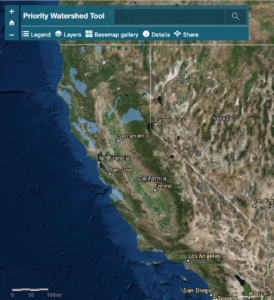It is essential for cannabis cultivators to be aware that their right to cultivate cannabis is NOT solely determined by their compliance with local regulations and submittal of a complete application to CalCannabis. Within the CalCannabis Regulations is a provision – Section 8216 – that allows for CalCannabis, in connection with the California Department of Fish and Wildlife (“DFW”) and the State Water Resources Control Board (“SWRCB” or “the Water Board”), to determine whether California’s watersheds are adversely impacted by cannabis cultivation.
Understanding Section 8216 of CalCannabis’ Regulations
Section 8216 of the CalCannabis Regulations, “License Issuance in an Impacted Watershed” states the following:
“If the State Water Resources Control Board or the Department of Fish and Wildlife notifies the department in writing that cannabis cultivation is causing significant adverse impacts on the environment in a watershed or other geographic area, pursuant to section 26069, subdivision (c)(1), of the Business and Professions Code, the department shall not issue new licenses or increase the total number of plant identifiers within that watershed or area while the moratorium is in effect.”
This provision means that the state may determine that they cannot issue any additional commercial cannabis cultivation permits, or increase the total number of plant identifiers within a specific watershed.
A plant identifier is a Unique Identifier or “UID”, which is “an alphanumeric code or designation used for reference to a specific plant on licensed premises and any cannabis or cannabis product derived or manufactured from that plant.” In accordance with Section 8403 of the CalCannabis Regulations, licensees with immature plants are required to assign a UID to each established lot (which lot must be uniform in strain or cultivar, and which cannot have more than one hundred (100) immature plants at any one time).
Additionally, each mature plant must be tagged with a UID and licensees with mature plants must apply a UID to all individual plants once the plant is moved to the designated canopy area, or when an individual plant begins flowering. (Also note that licensees may tag individual immature plants prior to moving the plant to the designated canopy area or prior to the plant flowering.)
Therefore, if the state determines that it cannot increase the total number of plant identifiers within a watershed, the cultivators within that watershed will not be able to increase their cultivation size or request a larger number of UIDs.
State Water Resources Control Board Regulations
I along with fellow cannabis regulatory compliance attorneys at Rogoway Law Group have discussed Section 8216 with the State Water Board; we were told that the Water Board will be monitoring California watersheds to determine the cumulative impacts of cannabis cultivation.
When an action is taken under Section 8216, the state will NOT be revoking existing cultivation licenses, but rather, they will not issue additional plant identifiers to existing licensed cultivators. This will effectively limit licensed cultivators from expanding the number of plants they have on their premises.
The Water Board also stated that at this time, there is not enough information to determine whether currently noticeable impacts to California watersheds are due to illegal cannabis cultivators or because of legal, licensed operations; it is not the Water Board’s intent to “hammer” legal operators for the impacts caused by illegal cultivation operations, so the Water Board is still working out how to deal with adverse impacts to watersheds.
Cannabis Priority Watersheds
In addition to Section 8216 and the information provided to Rogoway Law’s regulatory compliance attorneys by the Water Board, the State Water Board’s Priority Watershed Information webpage has the following statement:
The State Water Resource Control Board (State Water Board) in coordination with the California Department of Fish and Wildlife (DFW) have identified “Cannabis Priority Watersheds” throughout the state that are of special environmental concern and are at increased risk of environmental impacts due to cannabis cultivation activities. The State Water Board and DFW intend to increase both permitting outreach and enforcement efforts in Cannabis Priority Watersheds. Our main goals in establishing Cannabis Priority Watersheds and developing a public online mapping tool for those watersheds are to:
- Improve voluntary regulatory compliance with the State Water Board’s Cannabis Policy and CDFW’s Lake and Streambed Alteration Agreement (LSAA) Program;
- Increase permitting enrollment for the State Water Board’s water rights and water quality permits, and DFW’s LSAA Program;
- Identify targeted watersheds for increased public outreach and education about impacts of cannabis cultivation and areas of special environmental concern;
- Protect public trust resources and habitat, as well as senior water right holders.
This page also has a “Priority Watershed Map“, which allows cultivators to determine whether their parcel is located within a Priority Watershed.

The State Water Board clarified to our compliance team that the existence of a cannabis cultivation premise within a Priority Watershed on the Priority Watershed Map, and the impacts of CalCannabis Regulations Section 8216 are separate issues to be considered.
The mapping of Priority Watersheds on the Water Board website means that the state has identified the watersheds as areas that they need to focus outreach efforts, due to a large quantity of cultivation operations, but low compliance with the Water Board’s Cannabis Cultivation program requirements. The Water Board’s outreach in such areas will be focused to encourage compliance with the cannabis policy requirements, which include the Cultivation General Order and the Cannabis Small Irrigation Use Registration (“SIUR”) permitting process.
Cultivation General Order & the Cannabis SIUR Permitting Process
The Water Board’s Cannabis Cultivation Program states the following in regard to the General Order and the SUIR permitting process:
Water Quality – Cannabis Cultivation General Order
The purpose of the Cannabis Cultivation General Order is to ensure, to the greatest extent possible, that discharges to waters of the State do not adversely affect the quality and beneficial uses of such waters. The Cannabis Cultivation General Order is a simplified Waste Discharge Requirement (WDR) available to cannabis cultivators to regulate discharges of waste associated with cannabis cultivation. Threats of waste discharge may be from irrigation runoff, over fertilization, pond failure, road construction, grading activities, domestic and cultivation related waste, etc. The Cannabis Cultivation General Order WDRs may be referred to as a “Water Quality Permit” or a “Water Quality Protection Enrollment” by other agencies.
The Cannabis Cultivation General Order implements the Cannabis Policy requirements and addresses activities related to cannabis cultivation or associated land development. Cannabis cultivation activities may occur indoor or outdoor. All commercial cannabis cultivators must obtain coverage under the Cannabis Cultivation General Order.
Water Rights – Small Irrigation Use Registration (SIUR) for Cannabis Cultivation
The SIUR implements the Cannabis Policy which requires cannabis cultivators to forbear (or cease) from diverting surface water during the dry season. The State Water Board has developed the Cannabis SIUR Program as an expedited process for cannabis cultivators to develop and install storage. The Cannabis SIUR allows for the diversion and storage of up to 20 acre-feet per year and incorporates the requirements of the Cannabis Policy, amongst other requirements, as general conditions.
You can find more information regarding the Cannabis Cultivation General Order and SIUR applications on the State Water Board website. For further information or a legal consultation, please contact Rogoway Law Group’s regulatory compliance team to discuss how the State Water Board’s policies may impact your ability to conduct commercial cannabis cultivation.



